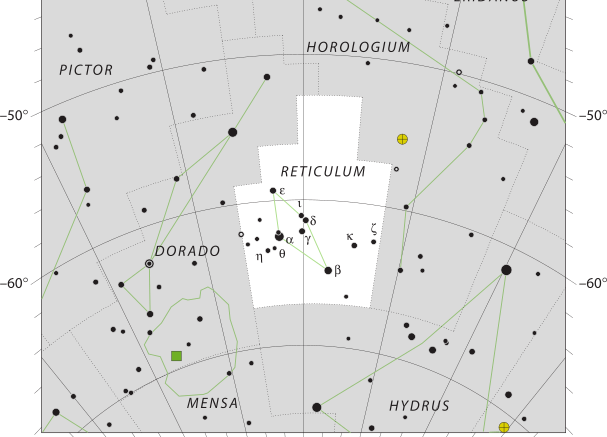Reticulum is a small, faint constellation in the southern sky, which means a net of crosshairs at the focus of a telescope eyepiece that is used to measure star positions in Latin. The constellation is best viewed between October and December, but it cannot be seen from middle to northern latitudes, which includes the Pacific Northwest.
The boundary for the reticulum constellation was drawn up by Belgian astronomer Eugène Delporte along arcs of right ascension and declination for epoch 1875. Reticulum would became an officially recognized constellation during the First General Assembly of the International Astronomical Union in 1922.
| Applicable Information | |
| Visibility In Pacific Northwest | Never visible |
| Best Times To View | Not visible |
| Right Ascension | 4h |
| Declination | −60° |
| Area | 114 square degrees |
| Main Stars | 4 |
| Brightest Object | α Ret |
| Meteor showers | 0 |
| Messier objects | 0 |
| Neighboring Constellations | Horologium, Dorado, and Hydrus |
The Name
The first iteration of this constellation was in 1621, when Isaac Habrecht II introduced it in his celestial globe in 1621, with the name Rhombus. It was replaced with a somewhat different constellation by the French astronomer Nicolas Louis de Lacaille in the eighteenth century; during his stay at the Cape of Good Hope, he named the constellation le Réticule Rhomboide to commemorate the reticle in his telescope eyepiece. The name was later Latinized to Reticulum in his star catalogue Coelum Australe Stelliferum.
Stars
Only two of the stars in this constellation are brighter than visual magnitude 5, which are Alpha and Beta reticuli. The reddish star R Reticuli is a Mira variable, which was discovered by C. Ragoonatha Chary at the Madras Observatory in India.
Make sure to check out other articles on the site, including a brief introduction to constellations, other constellation articles, and more!

Be the first to comment on "Reticulum"